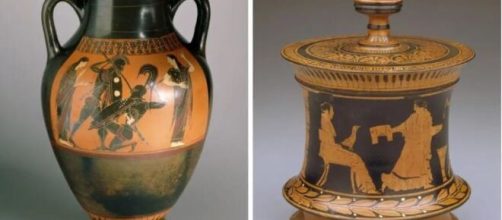Vandalizing is an ancient practice. Trashing artworks is as old as the seven hills of Rome when the German tribe called Vandals sacked the city of Rome leaving many antiquities in ruin.
Last month, antiquity took another hit when 21-year-old Brian Hernandez broke into the Dallas Museum of Art and “seriously damaged” ancient Greek artifacts, museum director Agustin Arteaga told the press.
Two ceramic items – one black-figured and the other red-figured dating to the 5th and 6th centuries, said to be valued at $1 million – were wrecked. But Arteaga appeared to excuse the wreckage.
Temper tantrum
“It was just someone who was going through a moment of anger and found this as a way to express it.” Law enforcement saw Hernandez’ melt-down differently. He was charged with criminal mischief, which is a felony.
A second act of vandalism occurred last month when a man visiting the Louvre masquerading as an old woman in a wheelchair, leaped up to smear cake on the glass protecting the "Mona Lisa." He said he was protesting the attention given to the painting rather than to climate change. He was placed in psychiatric care.
“Why do people attack artworks?” The Guardian asked this of art historian Noah Charney, who specializes in art crime. In his view, certain works set people off with no agenda involved.
But if there is an agenda, Charney says his research indicates that vandalized artworks are “usually those that are sexualized.” He cited the 1914 slashing of Velasquez’s nude "The Rokeby Venus" at London’s National Gallery by a suffragette. She didn’t like to see women objectified, he said.
His thinking falls short given that the prim, far-from-sexualized "Mona Lisa" has been vandalized five times, beginning in 1956 when acid was thrown at her, missing her face. And in that same year, a man tried to smash Mona with a rock.
Sex has nothing to do with those attacks, unless you buy into British art critic Jonathan Jones’ contention that the lady was sick with venereal disease, namely syphilis.
Art News magazine had a different take on art vandalism, saying in a 1987 report that lack of appreciation on the part of the public is the cause of most attacks.
Feeling left out
The magazine’s report concluded that art vandals are “ordinary people” who expressing their “incomprehension of artistic values” and fury at being excluded from the "elite world of cultured activity.''
Neat theory, but it doesn’t account for the attack on benign, easy-to-digest artworks like Greek pottery or the "Mona Lisa." There’s nothing obscure about either work.
But wait, the Art News report offered another theory: While modern art can provoke some to rage, attacks on Old Master is an act of an unbalanced mind.
In that case, you can tag me unbalanced because I have long harbored thoughts of wiping that smirk off Mona’s face. As I see vandalism, it’s a form of art criticism.
I’m thinking of the art students from Ecole des Beau-Arts who once felt so turned off by a collage made by Man Ray that they riddled with it bullets.
Then there was Marcel Duchamp who was so disaffected by the Mona Lisa that he drew a mustache and beard on a reproduction for exhibition.
Probably the most radical form of art criticism came when artist Robert Rauschenberg showed his disdain for a Willem de Kooning drawing by erasing it and titling it “Erased De Kooning Sketch,” and put his own name on it. Sounds like a kind of art criticism to me.


